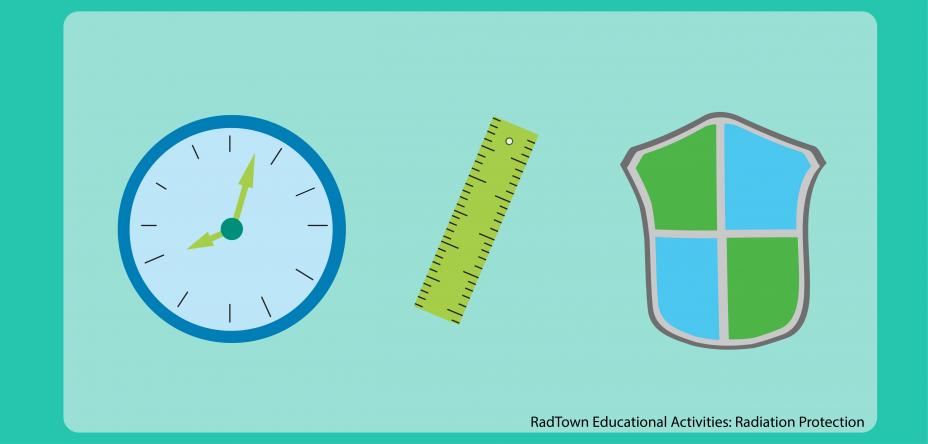Ionizing radiation has so much energy it can knock electrons out of atoms. But, when used properly, ionizing radiation has useful applications in the world around us. Food irradiation does not make food radioactive, but kills harmful bacteria that can make us sick. Nuclear medicine can help treat illnesses like cancer. Learn more about the ways ionizing radiation can be useful to us in this activity. This activity is intended for middle and high school students.
- Objectives
- Next Generation Science Standards
- Materials and Resources
- Time
- Vocabulary
- Directions
- Common Core State Standards
- Printable Worksheets and Classroom Aids
Objectives
Students will examine how radiation is often used in devices and processes that help protect us and ensure our safety.
Next Generation Science Standards
The concepts in this activity can be used to support the following science standards:
- PS4. Waves and Electromagnetic Radiation
- ESS3. Human Impact
Materials and Resources
Each italicized document title can be found at the bottom of this page, and is available for printing and distribution.
- Radiation Protection: Teacher Background Information
- Vocabulary Materials
- Benefits and Unintended Impacts Worksheet (one per student, pair or group)
- Paper and/or poster board and colored pencils, pens or markers (optional)
- Student computers with Internet access to the following and a printer: (optional)
Time
You may choose to have students complete the entire activity within one or two (45-60 minutes) class periods. If time or computer access is limited, the activity can be introduced, completed outside of the class and concluded in another class period.
Vocabulary
- Alpha particles
- Beta particles
- Gamma rays
- Ionizing radiation
- Radiation
- Radioactive atom
- Radioactive material
Directions
- Start with a vocabulary activity if students are not familiar with radiation and the terms used in this activity, or provide students with the terms and definitions.
- Explain that we use radioactive elements in many devices, processes and treatments that are beneficial and life-saving. These elements may emit ionizing radiation in the form of alpha or beta particles, x-rays and/or gamma rays.
- Have students brainstorm sources of ionizing radiation and their useful purpose. You may want to list student responses on the board. Examples include irradiation (used to kill bacteria in food and on medical tools and devices), diagnostic nuclear medicine, nuclear energy, moisture and density nuclear gauges (used to construct stable and safe road and highways), navigation beacons and buoys, security screening devices, radiation testing and protection devices, ionizing smoke detectors and devices used to test for leaks or cracks in pipeline and aircraft parts.
- Distribute the Benefits and Unintended Impacts Worksheet. Answers on this worksheet will vary. Supporting material for educators can be found in Radiation Protection: Teacher Background Information.
- Direct students to:
- Select a device, a process or a treatment that uses radiation. Students may refer to RadTown fact sheets (A-Z Subject Index) or the links provided under Materials and Resources below.
- Identify the type of radiation used (alpha or beta particles, x-rays and/or gamma rays).
- Research and list the benefits of the selected device, process or treatment including supporting data.
- Research and list the impacts that may result from developing or using this radiation source, include supporting data, and consider social, economic and environmental impacts. For example, a potential social impact of nuclear medicine is that people may live longer by surviving illnesses like cancer; economically there are costs associated with the proper storage and disposal of radiation sources; and environmentally, radiation sources that are not disposed of properly may lead to radiation contamination.
- Determine whether they think benefits outweigh the impacts.
- Optional: Find or create a visual diagram that describes the technology and use of the radiation source.
- Have students share their findings and thoughts on whether the benefits outweigh the impacts. Some uses of radiation may be more controversial than others. Allow students to comment on or debate the issues.
- Explain that agencies like the U.S. Environmental Protection Agency (EPA) help monitor and manage potential impacts and protect us and our environment from radiation exposure or contamination.
- Students should determine that:
- Radiation is a part of our daily lives.
- There are many benefits and uses of radiation.
- Ionizing radiation may present health and environmental risks if not handled or disposed of properly.
Common Core State Standards (CCSS)
The concepts in this activity align with the following CCSS English Language Arts Standards for Literacy in History/Social Studies, Science, & Technical Subjects:
- CCSS.ELA-LITERACY.SL.6-12.1 Comprehension and Collaboration
- CCSS.ELA-LITERACY.WHST.6-12.7 Research to Build and Present Knowledge
- CCSS.ELA-LITERACY.WHST.6-12.8 Research to Build and Present Knowledge
- CCSS.ELA-LITERACY.WHST.6-12.9 Research to Build and Present Knowledge
- CCSS.ELA-LITERACY.RST.6-12.2 Key Ideas and Details
- CCSS.ELA-LITERACY.RST.6-12.7 Integration of Knowledge and Ideas
Printable Worksheets and Classroom Aids
You may need a PDF reader to view some of the files on this page. See EPA’s About PDF page to learn more.- Benefits and Unintended Impacts Worksheet (PDF)(2 pp, 162 K)

